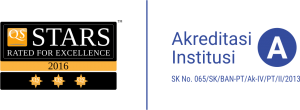Online and Offline Assessment Process: The Advantages and Disadvantages
The spread of COVID-19 has several impacts on many countries. One of the affected countries is Indonesia. On the 2nd March of 2020, the president announced the first case of COVID-19 in Indonesia. The first case was found in Depok, West Java. Not long after the first case was found, the number of the other cases started to increase. There are numerous cases of COVID-19 throughout the year 2020. The increase of COVID-19 affected many sectors, including the sector of education. The Ministry of Education, Culture, Research, and Technology has issued Circular Letter No. 4 of 2020 regarding the Implementation of Internal Education Policy COVID-19 Emergency. The policy informs that all stages of education teaching and learning activities are conducted in an online distance learning system. According to Kustandi and Darmawan (as cited in Eddy, 2021), distance-learning or in Indonesian we know it as pembelajaran jarak jauh (PJJ) is a learning that is not done face-to-face (like conventional learning), but done remotely without a physical classroom and can be done anywhere and anytime. In the online learning system, students and teachers are implementing the learning activities using online platforms such as Google Classroom, Google Meet, Zoom, etc. The changing of the learning system affects the whole process in learning activities such as delivering the materials, assignments, and assessments. This essay will focus on discussing assessment in online and offline learning systems during the pandemic.
For the safety of the teacher and student during the pandemic, an online learning system is the only option to conduct the learning process. By following this option, they need an online platform for the whole process. The learning activities will run if the platform of the learning system can be accessed both by students and teachers. There are so many e-platforms to support the assessment process. For instance, Quizziz, Google Form, Google Classroom, and the website of the institute. Besides, communication apps such as WhatsApp and Line are also needed to maintain coordination between teachers and students during the assessment process. The use of each app will be different regarding the features that are available in every app. For example, in the Quizziz, students work on quiz questions that are made by the teacher by entering a 6-digit code that is obtained from the Quizizz app. Quiz questions can be done at the same time (real time) and students can see the results and rankings directly. Meanwhile, in using the Google Form the teacher can provide variations of assessment. There are many types of questions that can be selected by the teacher in accordance with the needs of each subject. For example, the teacher can select a short answer, paragraph, and multiple choice.
When the teacher and the student hold the assessment or evaluation, there is no strict supervision from the teacher directly. It happens because the teacher and the students are not in the same place. So, there is a possibility for the students to cheat on their assessments. For example, the student could open their book or search for the answers through the other device. As the result, some schools are making a rule to use two or three devices. One of the devices is used to do the assessment while the other device is used to monitor the student’s activities during the assessment through Zoom meeting or Google Meet with the camera on. Other than cheating, there is a possibility for the student to get the question of the assessment by screenshot or capturing it and they can share it with another student who has not done the assessment.
After explaining the online assessment process, the author would be analyzing the face-to-face assessment process. There are several distinctions among both of them. In the previous paragraph, we know that we need an e-platform to conduct the assessment. On the other hand, in the offline learning system, we usually held the assessment in the real classroom. There are two options for the teacher to choose for the assessment. The first one is using paper as the question and answer sheets, and the second one is the student using the school’s computer to do the assessment. Those two options give flexibility for the teachers to determine which one is appropriate for their subjects. Unfortunately, these options are not safe for the pandemic situation because they can increase the cases of COVID-19. But if some schools are requiring offline assessment, the teachers need to prepare the classrooms by following the health protocol from the Ministry of Health. They also need to arrange different schedules that are divided into several shifts because there are limitations of the number of students who attend the assessment.
Regarding the supervision of offline assessment, it can be stricter because of many elements on it. First, the teacher could keep an eye on the students directly in the classroom. Direct supervision can diminish the possibility of the student cheating with other students. Apart from having the teacher as the supervisor, some schools also provide Closed Circuit Television or CCTV in each class to monitor the assessment process. By using the CCTV, the teacher could replay the video recording during the assessment to make sure that there is no cheating behavior by students in the class. For the computer-based test of offline assessment, the students cannot capture or screenshot the question because they use the school device. So, the teacher can detect if the student is saving the picture from the computer. While in the paper-based test, it cannot be captured because the media is just a paper and usually the school has a rule for the student to return the question paper to the teacher after they finish the assessment.
Based on the explanation above, we can conclude that both in online and offline learning systems, especially in the assessment process, there are advantages and disadvantages. The disadvantages of the online learning system come from the difficulties in adapting to the online platform for the teacher and student. By using online platforms, there are possibilities for the students to cheat during the assessment process. The teacher must be stricter in monitoring the students during the assessment by providing Zoom meetings for the student and asking them to turn on the camera. Although there are disadvantages in the online learning system, the student and the teacher can still take advantages of online platforms to hold the assessment process. The online learning system can make sure that there are no face-to-face meetings that increase the spread of COVID-19. So, both the teacher and the student can run the learning process without the fear of COVID-19.
Meanwhile, in the offline assessment process, the teacher and student need to be aware of the spread of COVID-19 because of the face-to-face situation. Due to that situation, the school has no other choice but to implement the health protocol and provide different schedules for the student. However, with the strict rules of the offline assessment, the school can reduce the spread of COVID-19 and they can still monitor the student directly from the class. But it would be better if the option of offline assessment is avoided if the cases of COVID-19 increased.
Despite the fact that there are two options of assessment processes and each option has its own advantages and disadvantages, both teacher and student need to decide the best option for their situation. They can choose the online assessment if the situation is not possible to conduct the face-to-face class. While they can choose offline assessment as long as the situation is under control and safe for everyone. Certainly, all the parties are expecting the situation to get better. So that later on, they can choose online or offline assessment without worrying about the COVID-19 and the pandemic situation.
References:
Eddy, Ari Usman, & Haida Dafitri. (2021). Pelatihan Penggunaan Aplikasi Quizizz Sebagai Alternatif Media Evaluasi Pembelajaran Jarak Jauh. Jurnal TUNAS: Jurnal Ilmiah Pengabdian Kepada Masyarakat, vol. 2. no. 2. p. 56. http://dx.doi.org/10.30645/.v1i1.
Kebudayaan, Direktorat Jenderal Guru dan Tenaga Kependidikan Kementerian Pendidikan dan. (2020). Panduan Pembelajaran Jarak Jauh.
Biodata of the author:
My name is Balqist Nathania Daniswari. I am from SMA 7 Yogyakarta and now I am in 11th grade. I am interested in joining this competition because I want to improve my writing skill and broaden my knowledge about current issues.






Leave a Reply
Want to join the discussion?Feel free to contribute!